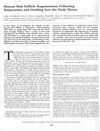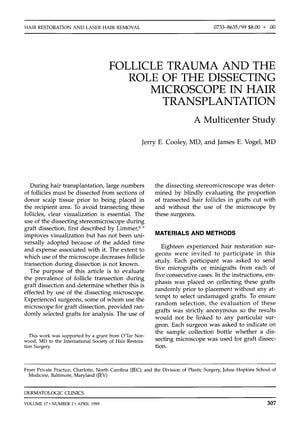TLDR Using microscopes in hair transplants reduces follicle damage.
In a 1999 study by Cooley and Vogel involving 12 hair restoration surgeons and 271 grafts containing 749 hair follicles, the use of a dissecting stereomicroscope during hair graft dissection was found to significantly reduce the rate of transected follicles from 20.0% to 10.2% (p < 0.05). This suggests that microscopes can decrease follicle trauma, potentially improving hair transplantation outcomes. However, the study also noted that transected follicles might still regenerate, indicating that the reduction in transection may not directly translate to increased hair growth. The findings support the use of pure follicular dissection and contribute to the validation of the follicular family unit concept in hair transplantation.
 2 citations
,
March 1997 in “Hair transplant forum international”
2 citations
,
March 1997 in “Hair transplant forum international” Transplanting rat whisker follicles can lead to successful hair growth after cutting them.
 72 citations
,
December 1996 in “Journal of Investigative Dermatology”
72 citations
,
December 1996 in “Journal of Investigative Dermatology” Human hair follicles can regenerate after removal, but with low success rate.
172 citations
,
December 1994 in “The Journal of Dermatologic Surgery and Oncology” This hair transplant method improves cosmetic results for hair loss.
15 citations
,
December 1994 in “The American Journal of Cosmetic Surgery” Half follicular grafts are not effective for hair transplants.
 October 2023 in “Facial Plastic Surgery”
October 2023 in “Facial Plastic Surgery” Beard hair is the best for body hair transplants, but the procedure is complex and requires experienced professionals.
 October 2021 in “Indian Journal of Plastic Surgery”
October 2021 in “Indian Journal of Plastic Surgery” You can use hair from other parts of the body for scalp hair restoration.
2 citations
,
September 2017 Hair and scalp diseases can affect hair transplant success in Asians, and managing them is crucial.
 October 1987 in “Clinics in Dermatology”
October 1987 in “Clinics in Dermatology” Scalp reduction can improve hair distribution in certain baldness cases but requires careful patient selection and understanding of facial structure.
8 citations
,
February 1982 in “Plastic & Reconstructive Surgery” Scalp reduction can effectively treat male pattern baldness, especially when combined with hair transplants.





